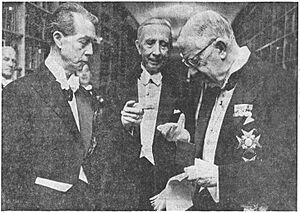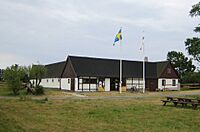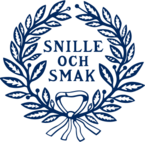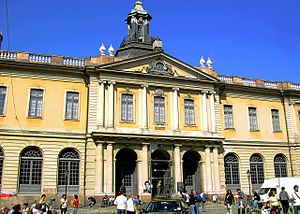Swedish Academy facts for kids
The Swedish Academy (Swedish: Svenska Akademien) was started in 1786 by King Gustav III. It is one of Sweden's Royal Academies. It has 18 members who are chosen for life. They are the top experts on the Swedish language. Outside of Sweden, the Academy is most famous for choosing who wins the annual Nobel Prize in Literature. This prize honors Alfred Nobel, who created it.
Contents
About the Swedish Academy
The Swedish Academy was created in 1786 by King Gustav III. It was inspired by the French Academy and has 18 members. The King chose 18 members because the Swedish phrase De Aderton (meaning 'The Eighteen') sounded very important.
The Academy's motto is "Talent and Taste" ("Snille och Smak" in Swedish). Its main goal is to help the Swedish language stay "pure, strong, and grand."
The Academy meets in the Stockholm Stock Exchange Building. This building was first used for trading and big parties. When the Academy started, its main hall was the largest warm room in Stockholm. So, the King asked to use it.
The Academy has held its yearly meeting there ever since. Members of the Swedish royal family often attend. In 1914, the Academy got to use the upper floor permanently. This is where they meet and announce the Nobel Prize winners. This important job makes the Academy one of the most influential groups in literature worldwide.
The King of Sweden is the only person, besides the members, who can attend the Academy's meetings. On March 3, 2022, the King attended a meeting. This was the first time a Swedish king had done so in over 200 years.
Academy Members

Members are chosen by a secret vote within the Academy. Before the choice is made public, the King of Sweden must approve it. Members include writers, language experts, literary scholars, historians, and a well-known lawyer.
At first, writers were a small group in the Academy. But in the 1900s, more than half of the 18 members became writers. For a long time, the Swedish Academy had mostly male members. However, the Academy has worked to become more equal. Since December 20, 2019, one-third of the members are women.
Before 2018, members could not resign; their membership was for life. The Academy could, however, remove members. This happened twice to Gustaf Mauritz Armfelt. He was removed in 1794, chosen again in 1805, and removed again in 1811.
In 1989, members Kerstin Ekman and Lars Gyllensten stopped attending meetings. They did this because the Academy did not support Salman Rushdie when a controversial book he wrote caused strong reactions. Another member, Werner Aspenström, also stopped attending for his own reasons. In 2005, Knut Ahnlund did the same. He was protesting the choice of Elfriede Jelinek for the Nobel Prize in 2004. He felt her work was not good for the prize. On November 25, 2017, Lotta Lotass said she had not attended meetings for over two years and no longer saw herself as a member.
Academy Property

Dag Hammarskjöld's old farm at Backåkra is near Ystad in southern Sweden. Hammarskjöld, who was the Secretary-General of the United Nations (1953–1961), bought it in 1957 as a summer home. The south part of the farm is kept as a summer retreat for the 18 members of the Swedish Academy. Hammarskjöld was also a member of the Academy.
On April 11, 2019, the Academy shared its financial reports for the first time. The report showed that at the end of 2018, the Academy had money and property worth about 1.58 billion Swedish kronor. This was about $170 million US dollars.
Past Challenges
The Swedish Academy has faced some challenges over the years.
Early Challenges
After King Gustav III died in 1792, the Academy's standing became weaker. In 1794, a member named Gustav Mauritz Armfelt was removed from the Academy. He was found guilty of plotting against the Swedish government. In 1795, the Academy was even paused for two years due to political reasons. Armfelt was later brought back in 1805. But after he had to leave Sweden for Russia, he was removed from the Academy again in 1811.
In 1881, another member, Henning Hamilton, was removed. He was found guilty of misusing money by faking a relative's signature.
Recent Challenges
In 1989, members Kerstin Ekman and Lars Gyllensten left their positions. They were protesting the Academy's choice not to speak out about a controversial book by writer Salman Rushdie. "I am so disappointed and sad that the Academy couldn't choose sides for or against Rushdie," Ekman said. "The Academy should have supported Rushdie, it is a question of freedom of speech." Gyllensten added, "Threats and pressure are against everything the Academy stands for." Soon after, Werner Aspenström also left his position. He did not say why, but he supported a stronger statement from the Academy. At that time, members could not officially resign, so the number of active members went down.
The Academy's choice to stick to its rule of not making political statements was criticized. Many felt it was important to speak up for free speech. In March 2016, the Swedish Academy did speak out against the threats made against Salman Rushdie.
2018 Events
In April 2018, three Swedish Academy members (Klas Östergren, Kjell Espmark, and Peter Englund) resigned. This happened after an investigation involving author Jean-Claude Arnault, who is married to Academy member Katarina Frostenson. Arnault faced accusations of bad behavior. He and his wife were also accused of sharing the names of Nobel Prize winners early. This could have allowed friends to make money from bets. Arnault denied all accusations.
Sara Danius, who was the permanent secretary, hired a law firm to investigate. They looked into whether Frostenson had shared secret information or if Arnault had too much influence. No legal action was taken against Frostenson. The investigation caused disagreements among the Academy members. After a vote about Frostenson's membership, the three members resigned in protest. Two former permanent secretaries, Sture Allén and Horace Engdahl, said Danius was not a strong leader.
On April 10, Danius was asked to resign from her role. This meant four seats were now empty. Even though the Academy voted against removing Katarina Frostenson, she chose to stop taking part in the Academy's work. This brought the total number of empty seats to five. Since two other seats were already empty from the earlier events, only 11 active members remained.
On May 4, 2018, the Swedish Academy announced that the Nobel Prize in Literature would be delayed until 2019. In 2019, two winners would be chosen. Even though it was still possible to choose a 2018 winner (only eight active members are needed), there were worries. People felt the Academy was not in a good position to give out the award fairly.
Many people thought this situation hurt the prize's reputation. King Carl XVI Gustaf of Sweden said that the rules might need to change. This included allowing members to resign from their lifelong positions. On March 5, 2019, it was announced that the Nobel Prize in Literature would be awarded again. Winners for both 2018 and 2019 were announced together. This decision came after the Swedish Academy made several changes to its structure and how Nobel Committee members are chosen. These changes were made to "restore trust in the Academy."
In November 2019, the Swedish Academy added five temporary outside members to help its Nobel Committee. These included writers, publishers, and literary critics. However, two of these new members left after only two weeks. One said that the work to change the Academy was taking too long.
Academy Dictionaries
To help keep the Swedish language strong, the Academy publishes three dictionaries.
- The first is a one-volume spelling dictionary called Svenska Akademiens ordlista (SAOL). It is now in its 14th edition.
- The second is a large, multi-volume dictionary called Svenska Akademiens Ordbok (SAOB). It is like the Oxford English Dictionary. The first volume came out in 1893, and the last one was finished in 2023.
- The third is a two-volume dictionary called Svensk ordbok utgiven av Svenska Akademien ('Swedish dictionary published by the Swedish Academy'). It covers modern Swedish and includes pronunciations, word origins, definitions, and examples.
All three dictionaries can be used for free online at svenska.se.
The Academy has also published a four-volume grammar book for the Swedish language (Svenska Akademiens grammatik, SAG). This book is for researchers and university students. There is also a smaller, single-volume grammar book for those who need something less detailed (Svenska Akademiens språklära, SAS).
Awards and Prizes
Since 1901, the Swedish Academy has chosen the winner of the Nobel Prize in Literature each year. This prize honors Alfred Nobel.
The Swedish Academy gives out almost 50 different prizes and scholarships every year. Most of these are for Swedish authors. People do not need to apply or compete for these awards. The Dobloug Prize is the largest of these, worth $40,000. It is a literature prize given for Swedish and Norwegian fiction.
The Great Prize
The Great Prize (Swedish: Stora Priset) was started by King Gustav III. This prize is a single gold medal. It is the most important award given by the Swedish Academy. Some famous winners include Selma Lagerlöf (in 1904 and 1909), Astrid Lindgren (in 1971), and Tove Jansson (in 1994).
Other Awards
The Academy gives out about 50 prizes each year. You do not need to apply or compete for them.
Current Members
Here are the current members of the Swedish Academy, listed by their seat number:
| Seat | Picture | Member | Born | Age | Elected | Notes |
|---|---|---|---|---|---|---|
| 1. |  |
Eric M. Runesson | 1960 | 65 | 2018 | |
| 2. |  |
Bo Ralph | 1945 | 80 | 1999 | |
| 3. |  |
David Håkansson | 1978 | 47 | 2023 | |
| 4. |  |
Anders Olsson | 1949 | 76 | 2008 | Permanent secretary 2018–2019 |
| 5. |  |
Ingrid Carlberg | 1961 | 64 | 2020 | |
| 6. |  |
Tomas Riad | 1959 | 66 | 2011 | |
| 7. |  |
Åsa Wikforss | 1961 | 64 | 2019 | |
| 8. |  |
Jesper Svenbro | 1944 | 81 | 2006 | |
| 9. |  |
Ellen Mattson | 1962 | 63 | 2019 | |
| 10. |  |
Peter Englund | 1957 | 68 | 2002 | Permanent secretary 2009–2015. |
| 11. |  |
Mats Malm | 1964 | 61 | 2018 | Permanent secretary |
| 12. |  |
Per Wästberg | 1933 | 92 | 1997 | |
| 13. |  |
Anne Swärd | 1969 | 56 | 2019 | |
| 14. |  |
Steve Sem-Sandberg | 1958 | 67 | 2020 | |
| 15. |  |
Jila Mossaed | 1948 | 77 | 2018 | |
| 16. |  |
Anna-Karin Palm | 1961 | 64 | 2023 | |
| 17. |  |
Horace Engdahl | 1948 | 76 | 1997 | Permanent secretary 1999–2009 |
| 18. | Vacant |
Permanent Secretaries
| Order | Seat | Picture | Permanent Secretary of the Swedish Academy | Born | Years | Notes |
|---|---|---|---|---|---|---|
| 1. | 11. |  |
Nils von Rosenstein | 1752 | 1786–1824 | |
| 2. | 13. |  |
Frans Michael Franzén | 1772 | 1824–1834 | |
| 3. | 12. |  |
Bernhard von Beskow | 1796 | 1834–1868 | |
| 4. | 5. |  |
Johan Erik Rydqvist | 1800 | 1868–1869 | pro tempore |
| 5. | 15. |  |
Ludvig Manderström | 1806 | 1869–1872 | |
| 6. | 12. |  |
Carl Gustaf Strandberg | 1825 | 1872–1874 | pro tempore |
| 7. | 9. |  |
Henning Hamilton | 1814 | 1874–1881 | |
| 8. | 11. |  |
Bror Emil Hildebrand | 1806 | 1881–1883 | pro tempore |
| 9. | 8. |  |
Carl David af Wirsén | 1842 | 1883–1912 | pro tempore in 1883–84 |
| 10. | 6. |  |
Hans Hildebrand | 1842 | 1912–1913 | pro tempore |
| 11. | 11. |  |
Erik Axel Karlfeldt | 1864 | 1913–1931 | |
| 12. | 14. |  |
Per Hallström | 1866 | 1931–1941 | |
| 13. | 13. |  |
Anders Österling | 1884 | 1941–1964 | |
| 14. | 7. |  |
Karl Ragnar Gierow | 1904 | 1964–1977 | |
| 15. | 14. |  |
Lars Gyllensten | 1921 | 1977–1986 | |
| 16. | 3. |  |
Sture Allén | 1928 | 1986–1999 | |
| 17. | 17. |  |
Horace Engdahl | 1948 | 1999–2009 | |
| 18. | 10. |  |
Peter Englund | 1957 | 2009–2015 | |
| 19. | 7. |  |
Sara Danius | 1962 | 2015–2018 | |
| 20. | 4. |  |
Anders Olsson | 1949 | 2018–2019 | pro tempore April–June 2018 |
| 21. | 11. |  |
Mats Malm | 1964 | 2019– |
See also
 In Spanish: Academia Sueca para niños
In Spanish: Academia Sueca para niños
- List of members of the Swedish Academy
- List of language regulators
- Bellman Prize
- Dobloug Prize
- Backåkra
Images for kids





